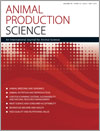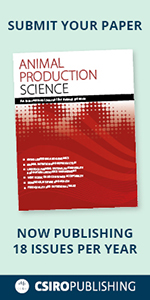
Animal Production Science
Volume 56 Number 12 2016
AN15297Resilience in farm animals: biology, management, breeding and implications for animal welfare
Exposure to novel situations, social challenges, humans and some disease organisms are unavoidable events in the life of farm animals. The way animals respond to these stressors is reviewed, a strategy for identifying individuals resilient to these stressors is proposed, and implications for breeding and managing animals to improve their resilience are discussed. Improving resilience should improve welfare, health and production of farm animals.
AN15297 Abstract | AN15297 Full Text | AN15297PDF (580 KB) Open Access Article
AN15725New biomarkers for intestinal permeability induced by lipopolysaccharide in chickens
Leaky gut can lead to compromised health and performance. Limited research in poultry prompted this research to investigate the model and biomarkers of leaky guts. This review may help in further studies.
AN15025Effect of late gestation bodyweight change and condition score on progeny feedlot performance
In the western United States, cows often graze low-quality forages during late gestation, which may have a negative impact on fetal growth and development. This study investigated cow bodyweight change during late gestation on cow and calf performance. Our results indicate that cows that have been adapted and managed to reproduce in harsh, limited nutrient environments may have the ability to maintain normal fetal growth and development during periods of maternal nutrient restriction.
AN14790The effect of feeding maize silage 1 h or 9 h before the herbage meal on dry matter intake, milk production, nitrogen partitioning and rumen function of lactating dairy cows
Previous studies provide some evidence of an effect of timing of supplementation on dry matter intake and productivity. However, there is still a lack of information on the effect of timing of supplementation on the performance and nitrogen excretion of lactating dairy cows subjected to feed restriction strategy. This study examined the effect of feeding maize silage at 1 or 9 hours before the herbage meal on dry matter intake, milk production, nitrogen partitioning and rumen function of lactating dairy cows. The results indicate that under herbage feed restriction, altering the time of supplementation relative to the herbage meal can increase herbage DM intake and subsequent milk production.
AN15199Meta-analysis of effect of a mono-component xylanase on the nutritional value of wheat supplemented with exogenous phytase for broiler chickens
Xylanases are a family of enzymes that hydrolyse arabinoxylan, a fibrous component of plant cell walls. Arabinoxylans are found in both soluble and insoluble forms distributed throughout various grains, legumes and oilseed meals and as such constitute a significant part of the fibre fraction of animal diets. Arabinoxylans increase intestinal viscosity and can negatively interfere with various digestive processes. Exogenous xylanases, added to the feed, partially hydrolyse arabinoxylans, reducing their antinutritional effect. Data presented herein confirm the continued efficacy of exogenous xylanases in the diets of poultry and shed light on the underlying trends and mechanisms involved.
AN14842Effect of fermentation of soybean meal with varying protein solubility on ileal digestibility of nutrients in growing pigs
Over processed or under processed soybean meal has adverse effects in the digestibility of protein and bioavailability of its constituent amino acids. The objective of this study was to evaluate the effect of fermentation on the low quality soybean meal with varying protein solubility. The results suggest that the low quality soybean meal could be improved through fermentation with Bacillus.
AN14669Sunflower meal and spring pea ruminal degradation protection using malic acid or orthophosphoric acid-heat treatments
Reducing ruminal degradation of high-quality proteins may decrease ammonia losses and increase the efficiency of microbial protein synthesis. The combined treatment of sunflower meal and spring pea with solutions of malic or orthophosphoric acids and heat reduced the ruminal degradation and improved the digestive availability of their proteins. These treatments may improve nitrogen retention by ruminants with associated benefits to the environment.
AN141007Nitrogen balance in Holstein steers grazing winter oats: effect of nitrogen fertilisation
A detailed understanding of nitrogen (N) balance in grazing steers is needed to improve N utilisation, reducing N losses and environmental pollution. N fertilisation leads to chemical modifications of the consumed diet, and hence in the animals. Steers grazing fertilised oats had greater N intake, N retention, average daily gain and N excretion than steers grazing non-fertilised oats. These findings are part of the onset of N cycle in grazing management situations. It is important to study the environmental impact of animal depositions grazing fertilised oats.
AN15300Influence of dietary glutamine supplementation on performance, biochemical indices and enzyme activities in broilers with cold-induced ascites
This study was conducted to investigate the effects of dietary glutamine supplementation on performance and biochemical indices of broilers with cold-induced ascites. Dietary glutamine supplementation had no effect on broiler performance. However, mortality due to ascites was reduced by dietary glutamine supplementation. We indicated that the beneficial effect of glutamine is probably related to its ability to maintain near to normal free radical scavenging enzymes and the level of glutathione peroxidase bioactivity, thereby protecting cell membranes from oxidative damage.
AN15068Validation of single photon absorptiometry for on-farm measurement of density and mineral content of tail bone in cattle
Diagnosing phosphorus deficiency in cattle is important because the deficiency is serious and widespread across northern Australia and is a major limitation to productivity. This research investigated the accuracy of measuring mineral density in the tail bones of live cattle as a practical and non-invasive way of detecting phosphorus deficiency. Accuracy was found to be sufficient to warrant further development of the diagnostic technique for on property use and as a research tool.
AN14943Estimation of bodyweight from body measurements and determination of body measurements on Limousin cattle using digital image analysis
In recent years, computer-aided and image analysis has been used for livestock production. Therefore, the objective of this study was to determination of body measurements and estimation of bodyweight from body measurements by using digital image analysis. The results indicated that digital image analysis can be used for accurate prediction of body measurements and bodyweight. Body area can be used for estimation of bodyweight.
AN15084Survey of long-term productivity and nutritional status of Leucaena leucocephala-grass pastures in subtropical Queensland
The factors that drive the productivity and commercial viability of aging leucaena pastures were studied. A field survey investigated the productivity of leucaena pastures ranging in age from 8–38 years and found phosphorus and sulfur nutrient deficiencies suppressed symbiotic nitrogen fixation and leucaena biomass yield. Monitoring plant nutrition and applying maintenance fertiliser will sustain the long-term (over 40 years) productivity of leucaena pastures.
AN14913Animal and human health is unlikely to be at risk when generations of sheep graze bauxite residue (Alkaloam®)-amended pastures
This research investigated concerns that bauxite residue (Alkaloam®), which is well recognised for increasing pasture production, could put animal and human health at risk. The aim was to show that when sheep graze pasture that has been improved with Alkaloam application, animal tissues do not accumulate dangerous heavy metals. There was no evidence that this occurred when two generations of sheep grazed improved pasture. This adds to the weight of evidence that suggests that Alkaloam may be a safe and highly effective way to increase productivity on Western Australia farms.
AN14989Minhota breed cattle: carcass characterisation and meat quality affected by sex and slaughter age
The Minhota cattle breed is native cattle from Portugal. The objective of this research was to study the effect of slaughter age and sex on carcass characteristics and meat quality of the Minhota cattle breed. Both entire male and female calf meat were of a strong light colour, a pale pink tone and had a high yellow index, which is common for animals without weaning.
AN14987Carcass cut-out value and eating quality of longisssimus muscle from serially harvested savannah-raised Brahman-influenced cattle and water buffaloes in Venezuela
Edible meat yield and flavour and taste of meat were compared at four ages for buffaloes and cattle. Although, buffaloes had lower proportions of lean cuts, buffalo meat exhibits more tender and flavourful steaks than does Brahman beef. Buffaloes may offer clear advantages for the Latin American meat trade, and consumers will be able to appreciate their palatability quality.
AN14661Effects of glycerin and essential oils (Anacardium occidentale and Ricinus communis) on the meat quality of crossbred bulls finished in a feedlot
Crossbred bulls fed with glycerin and essential oils improve meat quality. The aim of this study was to investigate the effects of glycerin and essential oils on meat quality of crossbred bulls finished in a feedlot. The glycerin addition in the diet did not alter meat quality and the essential oils improved the overall acceptability of the meat according to consumers.
AN14917Effect of protein level on growth performance, non-carcass components and carcass characteristics of young sheep from three breeds
This paper focuses on an important aspect of sheep production that has received little research, in this case the nitrogen requirements of young sheep. It shows that these needs are lower than the growth of young lambs. Therefore, a contribution of 11% of crude protein results in the same growth, carcass and composition importance of meat cut as a supply of 16%.
AN14906Sire breed and sex effects on the fatty acid composition and content of heart, kidney, liver, adipose and muscle tissues of purebred and first-cross prime lambs
This study compared purebred and crossbred prime lamb fatty acid composition (mg/100 g) of liver, heart, kidney, adipose and muscle tissues. Differences among tissue fatty acid compositions were evident, with lamb sire breed and sex influencing the profiles. These findings emphasise the potential for sire breed and sex flock-management approaches to achieve fatty acid-associated meat-quality goals and alternative lamb tissues as rich sources of beneficial fatty acids.
AN15032Effect of dietary mannan-oligosaccharides on some blood biochemical, haematological parameters and carcass traits in purebred New Zealand White and crossbred rabbits
The use of safe additives such as prebiotics is very interesting to avoid a public health hazard. This study examined the effect of dietary mannan-oligosaccharides on some blood parameters and carcass traits of purebred and crossbred rabbits. We found that 1.0 g/kg of diet mannan-oligosaccharides improved immunity, health, liveweights and carcass weights. We can recommend the spreading of these results on the commercial scale.
AN15094Dietary supplementation of a bacteriocinogenic and probiotic strain of Enterococcus faecium CCM7420 and its effect on the mineral content and quality of Musculus longissimus dorsi in rabbits
There is an increasing interest of consumers in a healthy lifestyle, e.g. energy and nutritional values of food, rich in protein and low in cholesterol and lipid contents, like rabbit meat. During the bacteriocinogenic and probiotic strain Enterococcus faecium CCM7420 administration to rabbits the iron content in carcass samples significantly increased. A diet enriched with the CCM7420 strain is beneficial for the health status of rabbits, involving the nutritional quality of rabbit meat in connection with consumers.
AN14744Do price premiums for wool characteristics vary for different end products, processing routes and fibre diameter categories?
Differences in price premiums for wool characteristics for end product-processing groups are unknown. Inclusion of this group information was better than broad FD categories in understanding wool price. Using price relative to market indicator improved price prediction. Price premiums can be used to estimate relative economic values for sheep breeding selection indexes and to determine more profitable wool clip preparation strategies.



